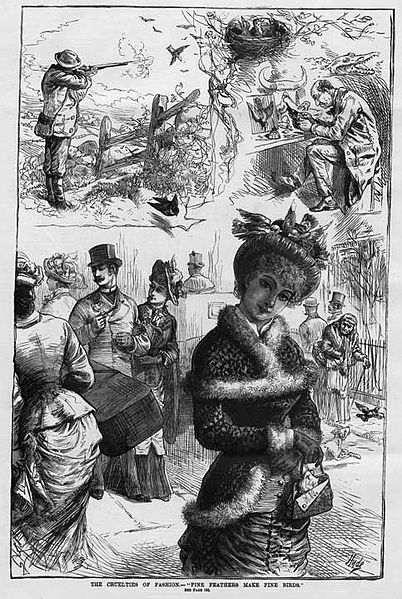
Men are dressed in top hats and long, formal coats while elegant women wear bustled skirts, their waists pinched in by corsets, and their heads adorned by large hats scattered with bright, colorful feathers. It’s the fashion of the day and the current craze is focused on those colorful feathers.
But, what had to die to fulfill this fashion craze?
BIRDS
From the great egret to the roseate spoonbill, populations of Florida wading birds were devastated by the early 1900s. Due to the milliner trade’s rising demand for bright feathers, plume hunters soon became plume poachers, killing millions of birds for their feathers each year. Bird populations soon plummeted because breeding plumage was in such high demand, with “prices [rising] steadily until the feathers were worth twice their weight in gold.”[1]
Some bird species were hunted to the point of near extinction, especially those in the Everglades. In response, Florida passed the Audubon Model Law in 1901, which outlawed plume hunting in the state.[2] Game wardens were then tasked with protecting the area’s wading birds from poachers and hunters.
In 1902, the Florida Audubon Society, a non-profit environmental organization dedicated to conservation, hired Guy M. Bradley (1870-1905) as a game warden. His territory stretched along Florida’s west coast through the Everglades to Key West. As he tried to enforce the ban on plume hunting throughout his large territory, Bradley was shot in the line of duty after he confronted a group of known plume hunters, who were loading murdered egrets into their boat.[1]
His death, as well as the deaths of game warden Columbus G. McLeod and South Carolina Audubon Society employee Pressly Reeves, “galvanized wildlife conservationists across the nation who intensified the campaign for an end to the reign of the plume hunters,” as “many were revolted [by] the slaughter of the wading birds for the whims of fashion.”[1]
Ironically, “the changing demands of style and fashion” eventually saved the wading birds of Florida’s Everglades. [1] Eventually, the Audubon Plumage Act of 1910, which prohibits the sale or possession of feathers from protected bird species.[3] Sadly, it would take decades for the local bird populations to recover. It wasn’t until 1935 that a nesting colony of roseate spoonbills was discovered again.[2] Since then, the Florida Audubon Society has taken up the torch of bird conservation in the Everglades.
Learn more about their important conservation efforts by exploring two of our Digital Collections:

Audubon Florida Tavernier Research Papers
The 996 digitized images in this collection reflect the focus of Audubon’s research and conservation efforts with Florida’s wildlife. The entire physical collection is housed in USF Libraries’ Special Collections. [5]
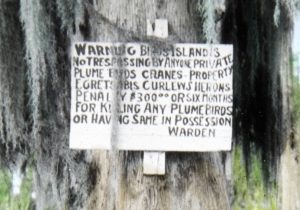
Audubon Florida Records, 1900-1970
The 173 digitized items in this collection cover a variety of topics, including daily journals of Audubon wardens and statewide reports on sites, projects, and activities from 1900 until 1970. [6]
View the images in the gallery below to see examples of this fashion craze, the bird species that were subsequently pushed to the verge of extinction, and the conservationists who attempted to save the wading birds of the Florida Everglades:
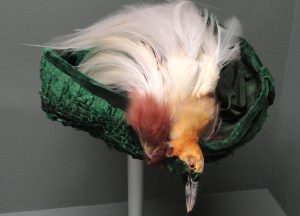



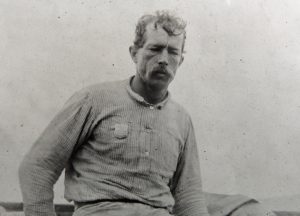
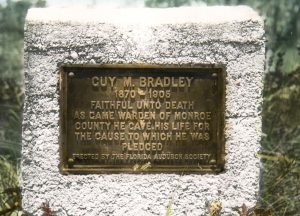
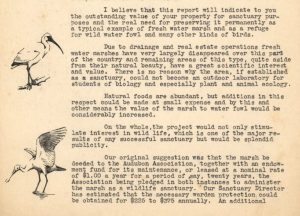
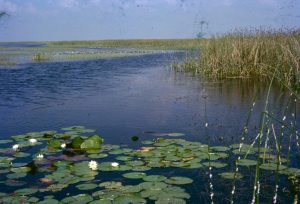
REFERENCES
[1] Huffstodt, J. T. (2014). Everglades Lawmen: True Stories of Game Wardens in the Glades. Rowman & Littlefield. Chapter 3 “Echoes of Gunfire.”
[2] Audubon Florida. (February 5, 2016). The Roseate Spoonbills of Florida Bay [Video]. YouTube. https://www.youtube.com/watch?v=JvQnUKEBVsI&feature=youtu.be
[3] Audubon, the National Audubon Society. (2020). History of Audubon and Science-based Bird Conservation. Audubon. https://www.audubon.org/about/history-audubon-and-waterbird-conservation
NOTES
[4] The first image in this post, “The cruelties of fashion: fine feathers make fine birds,” is in the Public Domain. It was originally published on November 10, 1883 in Frank Leslie’s Illustrated Newspaper, p. 184. Source: Historical Museum of South Florida, Endangered Species.
[5] The image used here, “Roseate Spoonbill Bathing” (A64-00993), is from the Audubon Florida Everglades Science Center Records collection, housed in USF Digital Collections.
[6] The image used here, “An anti-Poaching Sign on a Tree” (A64-00931), is from the Audubon Florida Everglades Science Center Records collection, housed in USF Digital Collections. The sign pictured in the image reads: “Warning Birds Island is Private Property. No trespassing by anyone. Plume Birds Cranes, Egrets, Ibis, Curlews, Herons, Penalty $300 or six months for killing any plume birds or having same in possession. Warden”
[7] The monument reads “Guy M. Bradley (1870-1905), Faithful unto death as game warden of Monroe County. He gave his life for the cause to which he was pledged.”